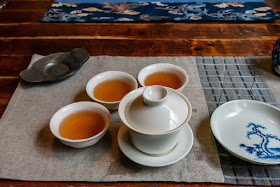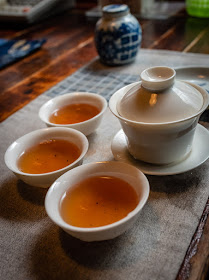The idea of learning to brew with a gaiwan is to focus on the fundamentals of tea brewing. So, in this spirit, I decided to use a very basic ivory color porcelain gaiwan.
Actually, Cosmin's request was even more specific. His focus was to learn to brew roasted Oolong in a gaiwan! That's why I chose this qingxin Oolong, high mountain, roasted and jassid bitten Zhuo Yan Oolong from Shan Lin Xi. The roast on this tea is particularly strong, which makes it a real challenge to brew well in a gaiwan.
Rolled Oolong requires energy to open up. It also requires a high temperature. That's why it's so important to preheat the gaiwan well. Water near boiling also helps to unfold the leaves. Then, it's possible to pour slowly and calmly on the leaves for the first brews.
The result is a beautiful color, excellent transparency and shine. The fragrances are a nice mix of roast and ripe fruits. The taste is sweet and very long. It's complex and rich like a pure malt whisky!
After showing how to brew, it's time to let Cosmin practice the gaiwan. Because if the theory is relatively easy, the practice is much harder. There are many details to keep in mind. And the best way to remain focused is to pour in the cups instead of in a gongdaobei (pitcher).
The trick not to burn your fingers is to hold the gaiwan by the egde of the cup. Again, easier said than done. I showed him and told him several points how to improve his brewing. I think it was helpful, because this is what he wrote to me afterwards: " Just want to say thank you for sharing that knowledge with me. I learned so many years by myself and caught a bit of info from all around, but this is first time I am properly guided.
I was very excited and overly happy on Saturday so it was hard to calm down, but those tips you shared have massive effect on the way I do tea.
Thanks for this feedback! As I explain in my Oolong Brewing Guide (which you receive for free if you a place a 60 USD+ order), "the goal of the first brew is to unfurl the leaves as evenly as possible in the gaiwan/teapot". You know your tea is well brewed if it tastes good and if you see that the leaves are evenly open in your gaiwan!










Stéphane, I can really appreciate and share your student's excitement, because I've managed to improve my tea brewing too, even by learning from you at such a distance.
ReplyDeleteI will definitely order some winter Zhou Yan oolong and see how it goes...
Elisabeth
Thank you Elisabeth for sharing your own learning experience from my blog!
ReplyDeleteThis winter Zhuo Yan Oolong is a great choice to drink now or to age for many years!
Stephane